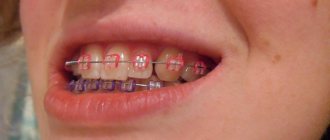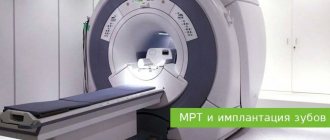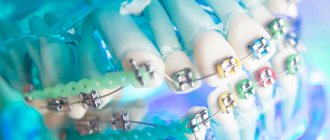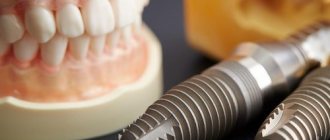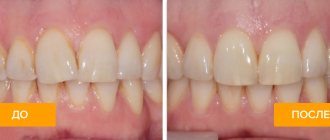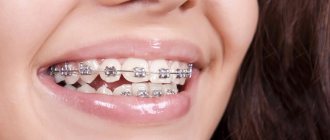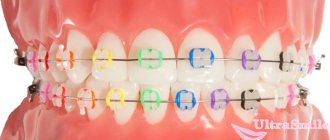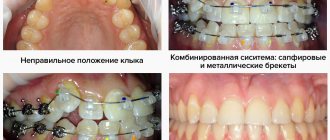Braces are worn for a long time: from 6-8 months to 2-3 years. Towards the end of treatment, many people wonder whether it is difficult to remove braces and whether it can be done independently at home, without contacting an orthodontist. We will tell you how orthodontic structures are dismantled and what will happen if you try to remove braces at home.
In this article
- How are braces installed?
- When are braces removed?
- How to remove braces
- What happens if you remove braces at home?
- Why is it dangerous to remove braces early?
- How to avoid complications
- Can braces be removed by another orthodontist?
Braces are installed to eliminate bite pathology. It is impossible to cure it in a short time - in a few visits to the doctor. Orthodontic treatment is quite long. In some patients, it begins at 3-4 years of age, when all the baby teeth erupt. First, the child wears plates, and at 12-13 years old he is fitted with orthodontic structures.
Children have to wear them for at least 6-12 months, and adults - from 1 to 3 years, depending on the disease. Throughout this time, the patient regularly visits the dentist to evaluate the effectiveness of the treatment and tighten the braces and increase their pressure on the jaws. The doctor makes a decision about the need to remove braces based on the results of a follow-up examination. It also allows you to outline a plan for further therapy.
During treatment, the patient gets used to orthodontic braces, but towards the end of treatment, the desire to remove braces arises more and more often. Many people are interested in whether it is painful to do this and whether it is permissible to dismantle the structure at home. To answer these questions, you need to understand how braces work, what determines the duration of orthodontic treatment, and how the procedure for removing braces takes place in the orthodontist's office.
When will it be possible to remove braces from my teeth?
To change the position of the teeth in a row, you will have to wear braces for quite a long time - at least several months, but positive changes will appear much faster. By assessing the results of treatment with braces, the orthodontist will be able to indicate to you the expected completion date of the bite correction course.
The timing of treatment will depend to a certain extent on you: if you want to remove braces from your teeth as quickly as possible and at the same time acquire a beautiful smile with straight teeth, you must strictly follow all the orthodontist’s recommendations and not miss visits to the clinic to monitor the results of the correction.
Calculate the cost of treatment by taking a short test in 20 seconds!
Do not delay your treatment, because in this matter time plays against us.
Prevention to prevent peeling
To minimize the risk of the bracket falling off the tooth, you need to follow the recommendations:
- — strict implementation of all orthodontist recommendations;
- - following a special diet that excludes too hard, viscous and sticky foods;
- - regular visits to the dentist to monitor the condition of the system and the success of treatment.
Be sure to read our instructions on how to properly brush your teeth with braces.
Strict adherence to all orthodontist prescriptions and timely visits to the doctor for arch correction are a prerequisite for effective bite correction without complications.
Posted by:
Removing braces: how to remove the orthodontic structure
Where can braces be removed and how will the procedure take place? These questions concern many people undergoing orthodontic treatment or just preparing to wear braces. Many people think that it is painful or unpleasant, or mistakenly assume that they can remove braces themselves, at home. In fact, it is impossible to remove braces without visiting an orthodontist’s office. This is a simple and non-painful procedure, so there is no need to be afraid of it. To remove braces from your teeth, the doctor will not have to perform any complicated actions; the removal process will go through quite quickly. Lingual braces are removed within an hour, conventional vestibular braces are removed even faster - in 20-30 minutes.
How does the process work? We will describe to you the procedure for removing braces from your teeth in detail. So, to remove your braces, you will go to the orthodontist, and the doctor will do the following:
- Install a retractor in the oral cavity, which will protect the soft tissues of the mouth and mucous membranes during removal of braces;
- Remove the braces system. To remove the structure, the orthodontist will first remove the arches and ligatures, and then the braces themselves.
But simply removing the braces is not enough - after removing the orthodontic structure, be sure to remove any remaining adhesive from the dental surfaces, grind and polish the tooth enamel, and then treat it with a special remineralizing compound.
Does it hurt to remove braces from your teeth?
One of the common questions from braces patients is: does it hurt to remove braces from your teeth? No, this procedure is painless and can be performed without the use of local anesthesia. Of course, some discomfort during removal of braces is not excluded, but it can be withstood without an anesthetic injection.
If you have a low pain threshold and high tooth sensitivity, warn your doctor about this. Then, before removing the braces, the doctor uses local anesthesia so that the removal procedure takes place without pain or discomfort.
Indications for replacement
There are two reasons for replacing the arc:
- Planned adjustments during treatment;
- Damage to the power element.
In the first case, the procedure ensures the maintenance of directed traction, under the influence of which the problematic units continue to move into their natural anatomical position. In some brace designs, the wire tension is changed using a screw element, however, each arch has a limit threshold, which is not always enough to complete the correction cycle.
The second situation is caused by the occurrence of mechanical defects that exclude the possibility of further operation of the structure. Such cases are extremely rare - modern techniques involve the use of high-strength materials, the likelihood of breakage of which is minimal.
It is worth noting that when replacing a power arc as part of a planned cycle, both the upper and lower elements are updated, whereas in the event of a breakdown, only the damaged part is replaced.
Can I remove braces myself?
One important thing you need to remember is that it is impossible to remove braces safely at home. In order to properly remove braces without damaging tooth enamel and soft tissues of the mouth, you need to have special knowledge, skills, and have dental instruments at your disposal. There are articles on the Internet that tell you how to remove braces at home, but do not follow the instructions given in them: this will not lead to anything good, you can damage your teeth and gums and provoke the development of an inflammatory process.
In addition, removing braces to complete orthodontic treatment is not enough. After the braces are removed, special structures are placed on the teeth - retainers, which secure the result of the bite correction and prevent the teeth from moving apart again. Retainers cannot be bought on the Internet or in a store, and what’s more, they cannot be installed correctly and securely on your own.
It is also impossible to remove the braces yourself because after removing the structure, the glue that was used to fix the plates remains on the teeth. To remove it, the surfaces of the teeth need to be sanded and polished. Remineralization of tooth enamel is also required to restore its structure after wearing braces for a long time.
What happens if you don't use retainers?
In this short section we will discuss the consequences of an unwise act. So, let’s assume that after your braces were removed, you decided to ignore all the recommendations and just went home, happy to get rid of the annoying structure that had been on your teeth for a year or two.
You won't notice anything in the first few weeks. Change comes slowly. Over time, the teeth will begin to gradually return to the positions from which they were displaced by the pressure of the arc.
Girl after removing braces
Within six months you will see that your teeth have become crooked again. This means that you have to repeat the entire procedure again, and a year or two of your life was simply thrown away along with the money you paid for the fabrication, installation and removal of braces. Isn't this prospect too impressive? Then listen to the doctor and do not be self-willed. This way you will save time, nerves and money. By the way, the cost of re-treatment will not be lower. In addition, all materials are imported, their prices are tied to the dollar exchange rate. So draw your own conclusions.
Many people find it difficult to come to terms with the fact that after two years of wearing an iron thing in their mouth, they will have to undergo some additional procedures, wear a retainer, etc. If they have been under psychological pressure all this time, the situation becomes more complicated.
The result of wearing braces
Is it possible to remove braces if the system breaks down?
Braces are durable structures that can withstand heavy loads well. But if the patient does not follow the doctor’s recommendations, the braces may come off. Even under these circumstances, you should not attempt to remove braces yourself! Such attempts may cause you to damage the entire system!
Therefore, there is no need to bother removing braces; your task in such a situation is to get an appointment with an orthodontist as quickly as possible, since the absence of even one element in the system disrupts the balance of the structure and significantly reduces the effectiveness of braces. If you cannot get to the orthodontist in the next day or two, visit the pharmacy, buy medical wax and use it to secure the bracket on the surface of the tooth from which it fell off.
Consequences of braces coming off
There is no need to think that peeling off the bracket from the tooth will not affect the process of orthodontic correction. Correction of the bite occurs due to the pressure of the power arc, which passes through all the locks. The absence of even one of them on the last or front tooth disrupts the effect of the entire system on the dentofacial apparatus. Because of this, tooth movement not only slows down, but also may occur in the wrong direction. Therefore, contacting an orthodontist when a lock comes off is a necessity.
What happens to my teeth after braces are removed?
One of the reasons why braces can only be removed in a dental clinic is the poor condition of the teeth. After removing braces, glue remains on the surface of the teeth; there may be noticeable cracks and white spots formed due to insufficient nutrition of the dental tissues while wearing braces.
It is important to understand that wearing braces negatively affects only aesthetics, but not the health of your teeth. Aesthetic defects will be easy to eliminate: to do this, it is enough to remove the braces, grind and polish the tooth enamel, and conduct a course of its remineralization. Usually these measures are quite enough to completely restore the aesthetics of the appearance of teeth.
But if you want to get the perfect Hollywood smile, then after removing braces, you can put veneers on your teeth, carry out the procedure for whitening tooth enamel, and resort to any other artistic restoration methods.
What procedures will be performed after braces are removed?
Removing braces does not mean ending the course of orthodontic treatment. First of all, the doctor will restore the aesthetic appearance of the teeth.
For this purpose, the following procedures are carried out:
1. Hygienic cleaning. This procedure allows you to remove residual adhesive, tartar and plaque from the surfaces of your teeth. Deposits actively accumulate under braces during the treatment period, and in order to keep teeth healthy, they must be removed.
2. Remineralization of tooth enamel after removal of braces. It is carried out by treating the surfaces of teeth with fluoride and calcium preparations, which saturate the weakened enamel with nutrients and restore its healthy structure.
We wrote above that after removing braces, you can do whitening to get a perfect smile. However, we advise you to remove your braces and wait about a month to whiten your teeth. During this time, the enamel and dental tissues will be sufficiently restored. If you whiten your teeth immediately after removing braces, there is a high risk of tooth hypersensitivity and even pain.
Patient opinions
Having studied numerous reviews about removing braces on specialized websites, forums and blogs, we can draw several conclusions:
- not all doctors know how to properly and accurately grind the surface of teeth;
- many patients blame their mistakes on the incompetence of the orthodontist;
- You should not go to budget and cheap clinics.
Removed braces
Let's start in order. In decent dentistry, specialized attachments are used to remove glue residues and work with high precision. This avoids significant damage to tooth enamel. But it should be understood that enamel is not a perfectly smooth surface. Nature created it lumpy. Therefore, it is physically impossible to sand off the glue from it without removing at least a minimum layer. Unless, of course, it is a micro-operation performed with a laser. But we are talking about real things. Therefore, after removing braces, the enamel is usually treated with remineralization agents. Special pastes and gels are also prescribed that perform the same function.
Second point. “I have crooked teeth again, it’s all the doctor’s fault.” Yes, it's a fact. Doctors do not always know how to work correctly with bite correction devices. But this has nothing to do with withdrawal. If after this procedure the teeth are straight, and then “suddenly” become crooked again, it is solely the patient’s fault. It all comes down to the situation described above with retainers that “forget” anywhere.
- White braces
Braces care
The third point in removing braces is choosing a clinic where the braces will be placed and removed. If you go to a city dentist, you may not be surprised that your enamel will be damaged. This is far from the worst of what happens in clinics. When choosing where to go, you should start with highly specialized forums. Explicit advertising is banned there. Therefore, it will be difficult to make a mistake. Ask your acquaintances, colleagues, friends. Check with those who have consulted orthodontists. They will definitely scold bad doctors and praise good ones completely sincerely.
We have given you comprehensive information about everything related to the process of removing various types of braces, making and wearing retainers. If you have any questions, you can write them in the comments or by email. Visit us more often and you won't miss anything useful. We wish you good health and equally strong teeth!
Why do you need to remove braces and put retainers on your teeth?
Many patients are upset by the fact that it is not enough to remove the braces and complete the course of bite correction: after removing the braces, they will need to wear special structures on the teeth - retainers. Wearing retainers helps to consolidate the achieved positive result in correcting the bite, because if you remove the braces and do not put on the retainers - without the pressure that the brace system puts on the teeth, they will tend to return to their previous position.
Retainers will hold your teeth in the correct position and prevent them from moving. After your braces are removed, your orthodontist may suggest that you install removable or permanent retainers.
Fixed retainers
They are the thinnest wire that is glued to the inner surface of the teeth from the tongue side. Filling materials are used to fix the wire; it will be absolutely invisible to prying eyes and will not cause any discomfort when worn.
Removable retainers
When you come to the orthodontist to remove your braces, the specialist may offer you removable retainers.
These structures can be in the form of thin plates or silicone mouth guards and are worn over the teeth while you sleep. After removing braces, retention mouthguards are made according to an individual impression and their use requires a certain amount of discipline from the patient - if you don’t put the mouthguard on every day and forget about it, you can nullify all the positive results achieved from wearing braces. How long will you have to wear retainers after your braces are removed? Let's answer honestly - the retention period after removing braces is usually quite long; its duration can exceed the duration of the correction course by 2-3 times. And besides, some patients will have to wear retainers after removing braces for the rest of their lives to maintain a beautiful smile with straight teeth.
Will my teeth hurt after my braces are removed?
You need to prepare for the fact that you will experience physical discomfort for some time after your braces are removed. It occurs because the teeth, after removing braces, tend to return to their previous position, and retainers prevent this.
High tooth sensitivity may also occur, explained by the fact that while wearing braces, tooth enamel becomes thinner and weakens. Therefore, pain may occur when drinking hot/cold drinks and food.
The orthodontist must warn you about such side effects before removing braces. In addition, the specialist should advise you in detail on the proper care of your teeth and oral cavity after removing braces and installing retainers.
How to properly care for your teeth and oral cavity after removing braces?
After removing braces, weakened tooth enamel and tooth tissue need time to fully recover. This is why it is so important to ensure proper oral hygiene. It is imperative to undergo professional teeth cleaning and teeth remineralization procedures - they are performed in a clinic and may require several visits to a specialist’s office.
At home, after removing braces, you must regularly and thoroughly brush your teeth, use an irrigator or dental floss to remove plaque from the interdental spaces, and use balms and rinses to prevent gum inflammation. In all these procedures it is necessary to use gels and pastes, which the orthodontist will recommend to you. Usually, pastes with a high fluoride content are prescribed, as well as special remineralizing gels, which are used to treat the teeth after brushing.
Calculate the cost of treatment by taking a short test in 20 seconds!
Do not delay your treatment, because in this matter time plays against us.
Is it possible to remove braces from teeth ahead of schedule?
It is possible to remove braces ahead of schedule only if the process of correcting the bite went faster than initially predicted. But such cases are very rare. More often, the need to remove braces ahead of schedule arises under the following circumstances:
- Conservative orthodontic treatment does not give a positive result. In this case, it is advisable to remove the braces and correct the bite with surgery;
- Braces will have to be removed if the system breaks down or if the patient has an allergic reaction to it.
Other reasons (including special occasions, significant events) are not considered valid for removing braces. Of course, if you insist, the doctor will remove the braces from your teeth and put them on after some time. But at the same time, you will have to install a new structure, and the treatment time may increase significantly. In addition, early removal of braces can have a negative impact on the functioning of the maxillofacial joint.
If you know that after some time a significant event is planned in your life, you lead a public lifestyle - it is best to initially make a choice in favor of aesthetic and invisible types of braces on the teeth - ceramic, sapphire, lingual brace systems. Then the braces will not have to be removed, and you will be able to complete the course of treatment without unnecessary expenses and visits to the clinic.
Arc failure
An extremely unpleasant situation that is unlikely to be corrected on your own. She requires an urgent visit to the dentist, which can disrupt many plans for the day. A broken power arc does not cause any particular discomfort to its owners. But you shouldn’t put off replacing it until later. And that's why.
Arc failure leads to the following negative consequences:
- disruption of the orthodontic treatment process;
- damage to the mucous membranes by the sharp ends of the wire;
- risk of swallowing a piece of arc with sharp ends.
Preventing damage to mucous membranes is not difficult. The same dental wax will help here. But if you swallow individual fragments of the arc, you can get a whole “bouquet” of problems. The fact is that the sharp ends of a rigid wire can damage the mucous membrane of the gastrointestinal tract.
In most cases, the fragment transits through the intestines and comes out naturally. But the medical literature describes cases when pieces of wire lingered in the esophagus, puncturing its wall at one end. To avoid complications, it is recommended:
- refrain from eating food before arriving at a medical facility and conducting examinations, so as not to provoke intense movement of the wire and damage to the mucous membrane;
- do not make active sudden movements.
At the clinic, the surgeon will order an x-ray. If a piece of wire gradually moves through the digestive tract, then there is no cause for concern. If the wire is still in the esophagus at the time of examination, it can be removed without surgery.
Unlike arch fragments, there is no need to worry about swallowed ligatures and clasps. They do not have sharp edges, so they cannot harm.
